The Epitome of a City-State
Vatican City is a unique little country, literally the
smallest country by population and area in the world. Nestled on a hill in the city of Rome, it
provides a number of things to do for daytime visitors whether catholic or
not. We set aside one of our three days
in Rome to explore the more popular attractions of Vatican City.
Vatican City is set apart from the other main attractions of
Rome, such as the Coliseum, because it was built much later on pretty much the
only available space. Originally a Roman
stadium occupied the space of the Vatican, and it remnants can still be seen
today, in the circular shape of Saint Peter’s Square and the Obelisk which
occupies its center, which still stands where it once stood in the center of
the stadium. Supposedly it was in this
stadium where most Christian Martyrs were killed, including Saint Peter, who
was buried nearby where the Basilica now stands.
 |
| The only fountain present in Saint Peter's square, a popular focus of many Vatican postcards. |
After the fall of the Roman Empire the Pope took control of
not only governing the church but also the city of Rome itself. With time the Popes would add to the land
under their control, essentially acting as king of the Papal States that
covered most the Italian Peninsula from Venice to Naples. At the end of the nineteenth century there
was a great push by Emmanuel II to unify Italy under one king. The Pope lost control
of the Papal States to the Kingdom of Italy and retreated within the walls of
Vatican from which he would not leave for decades. Finally in 1921 the Pope and Mussolini reached
a peace agreement forming the country of Vatican City, which can govern within
its walls as the Pope wishes, but leaving the once Papal States under the power
of the Italian Government.
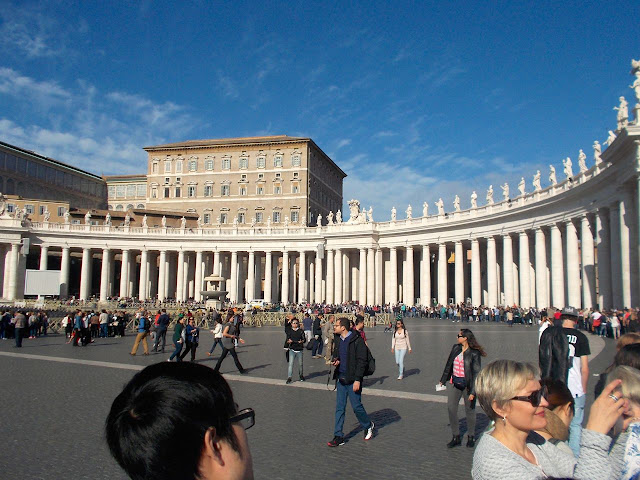 |
| The line to get through security (far left) into Saint Peter's Basilica wound half way around the square even on a week day in the off season. |
This divide is most clearly seen today in the abundance of
people trying to sell tours and selfie sticks just outside the Vatican City boundary. As soon as I crossed the
Vatican threshold into Saint Peter’s Square (the only part of Vatican City not
encircled by a wall) the press of sellers asking me every ten feet if I needed
tickets to something or other or thrusting selfie sticks and chargers into my
face hoping to make a sale disappeared.
It was magical.
 |
| Colosal is an apt adjective to describe the interior of Saint Peter's Basilica. |
The two most visited areas of Vatican City are the Basilica coupled with Saint Peter’s Square and the Vatican Museums. We went to Saint Peter’s Square and the Basilica
first. The square in and of itself could
be an attraction. The circular square is
enclosed by tall columns topped with sculptures. In the center of the square
resides the Egyptian obelisk while the huge Basilica looms over the entire
area, and the Swiss Guard oversee the only road from the square further into
the Vatican.
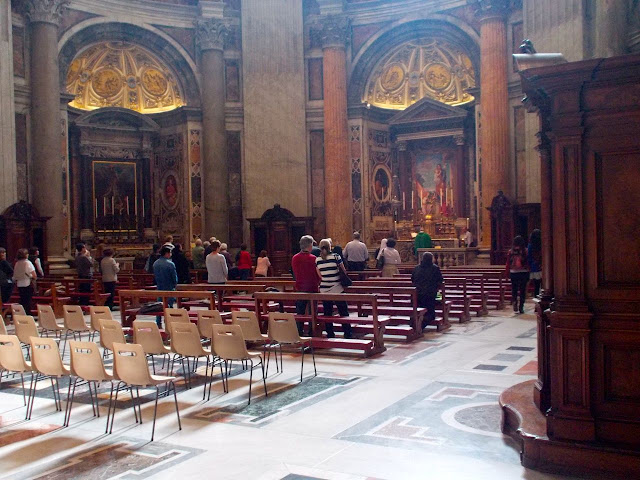 |
| Some Catholics gather for communion in one of the basilica's alcoves. |
Of course we did not merely want to see the Basilica exterior,
but the inside as well. So we got into
the security line. There is no charge to
enter the Basilica, but every visitor, including some nuns I saw, has to go
through a metal detector and their belongings through an x-ray machine. It was a weekday (Friday) and the off-season
(November) when we visited, and we had to stand in line for fifteen to twenty
minutes, although we did visit the Basilica in mid-morning, the busiest time of
the day.
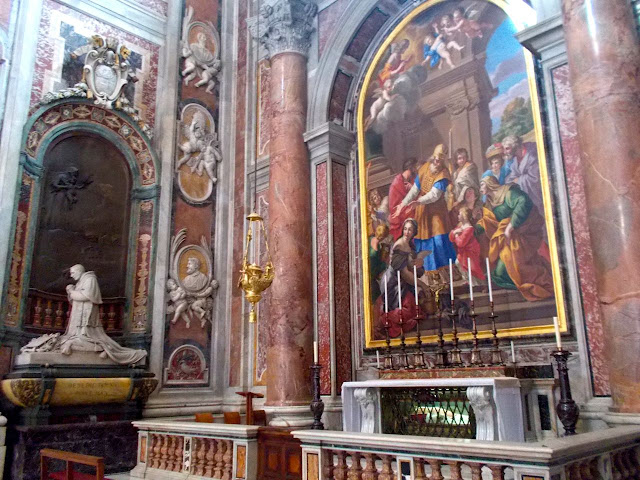 |
| Two tombs are present in the photo taken near the entrance in the basilica. That's not a painting above the tomb on the right, but a mosaic of tiles, a replica of the painting that once hung there. |
Once inside I was blown away by the sheer size of the
interior. I’ve been in large cathedrals
before in Florence and Liverpool, but Saint Peter’s Basilica blows them all
away in size. The size did not preclude intricate
decorations through out the Basilica.
Aside from the massive wood altar, statues and mosaics line the walls
and alcoves branching off from the main hall.
Most if not all of the artwork now within the Basillica are now mosaics
of tile. Even the once paintings were replaced
with tile, since tile stands up better to candle smoke and is easier to clean than a
painting.
 |
| The Swiss Guard guard the only road into the Vatican from Saint Peter's Square. |
Several of the alcoves offered services to Catholics, making
it somewhat of a one-stop-shop for atonement.
Areas for prayer, confession, and communion each have a dedicated space
of an alcove. Visitors can even buy
bottles to hold holy water in the gift shop.
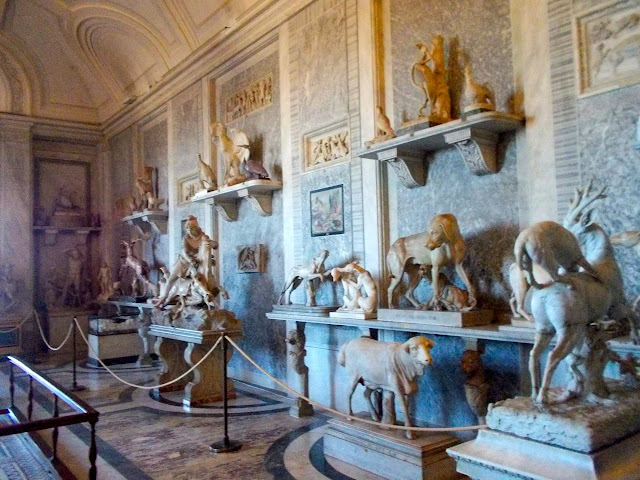 |
| This is the animal room of the Vatican Museum, named for the dozens of Grecco-Roman animal sculptures contained within its walls. The amount of art in the museums is numbing. |
Some people choose to ascend to the Basilica’s dome to take
in a view of Rome. We skipped this. There was quite the line and I didn’t feel
like paying the extra money beyond our already expensive Vatican Museum
tickets.
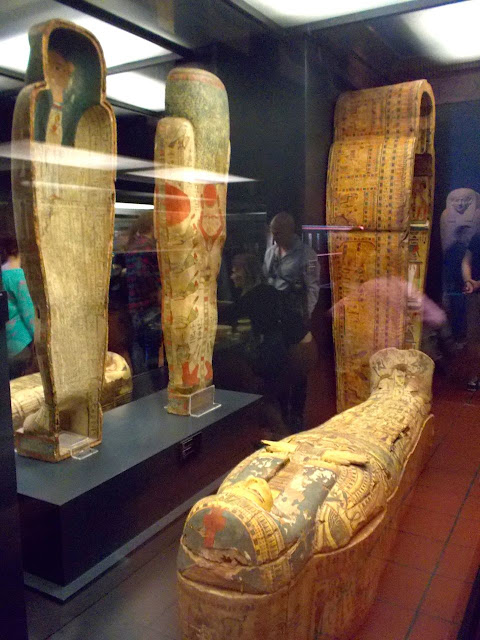 |
| The Popes apparently had no problem grave robbing these mummies from their resting places, now displayed in the Vatican Museums. |
The Vatican Museum is world renowned, if not for its art for
its lines. I had heard from several
people before our trip how they failed to visit the Vatican Museums, because of the multiple-hour wait in line, up
to four hours! I bought our tickets
online, paying the somewhat absurd four euro service fee per ticket for a three
o’clock entry time on a date I knew we would be in Rome. Unfortunately our trip to the Basilica did
not take long enough and we had a few hours to kill before our time slot. I hoped we could just go in early instead of
milling around for a few hours. So we
headed to the ticket office with our reservation confirmation and walked right
up to the will call desk. There was not a line for will call or for the regular ticket line either for that matter, a
benefit of going in the off-season on a weekday in the afternoon I
suppose.
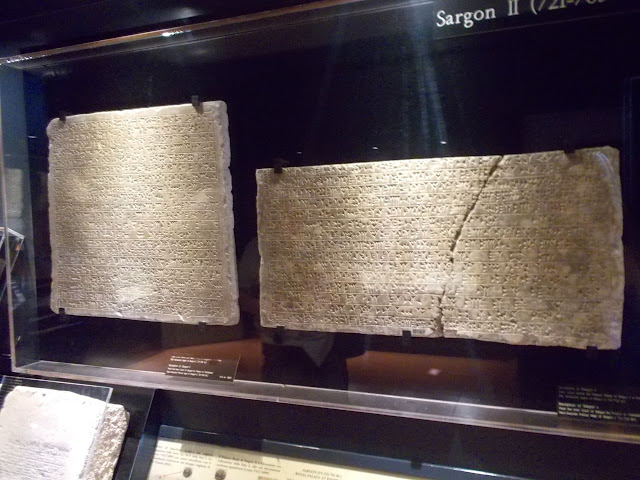 |
| Cuneiform tablets hide in one of the less-visited areas of the museums. |
The Vatican Museum exists due to the Popes’ love of
collecting. Really the Popes from the
era of the Papal States when just as any other king, they acquired items of
interest. The museum houses several
smaller museums of classic and neoclassic Greek and Roman sculpture, Egyptian mummies
and antiquities, modern art, Renaissance paintings, maps, tapestries, and
pottery. I think the pottery was my
favorite part of the museum since it housed artifacts more of historical
importance than artistic purposes, and the lack of massive tours groups. At least it was my favorite part until we
entered the Sisteenth Chapel.
 |
| These chariots piece together remains of chariot decorations and wheels. |
The Vatican Museums are praised for having such extensive
art collections. I agree much art is
contained within its walls, too much probably.
After hours of looking at so much art, it all started to look the same,
and I couldn’t tell a great work from a pile of rubbish. I was severely arted-out, and thought I would
just breeze through the Sisteenth Chapel, the main exhibit we wanted to
see.
 |
| One room of only maps commissioned specifically for the Vatican. Many have errors due to lack of knowledge during the time period they were made. |
Thankfully I was wrong and we spent a good twenty minutes
seated on a bench in chapel gazing skyward at one of Michelangelo’s greatest
accomplishments. I think my attention
was held so well, because the Sisteeth Chapel was so bright and colorful, a
stark contrast to the dark and brooding works filling the rest of the
museums. The awe of the chapel was not lost
on the rest of the visitors who filled its walls, with the Vatican Police
yelling every so often for silence and no photography. It is a holy place after all.
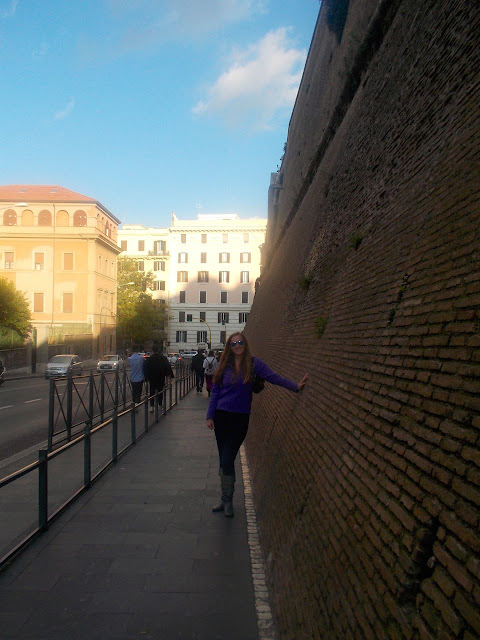 |
| Standing in Italy with a hand on the Vatican wall which encircles most of this tiny country. |
Visiting the Sisteenth Chapel was the last thing we did in
Vatican City before wandering around stupidly looking for but not finding the
exit, which was hidden within one of the many gift shops. It was nice to end out visit to this tiny
country on a high note, as undoubtedly the view within the chapel will be the
memory I will hold clearest in my mind, at least hopefully so since I couldn’t
take photos.
 |
| A three hundred and sixty degree view of Saint Peter's Square. |
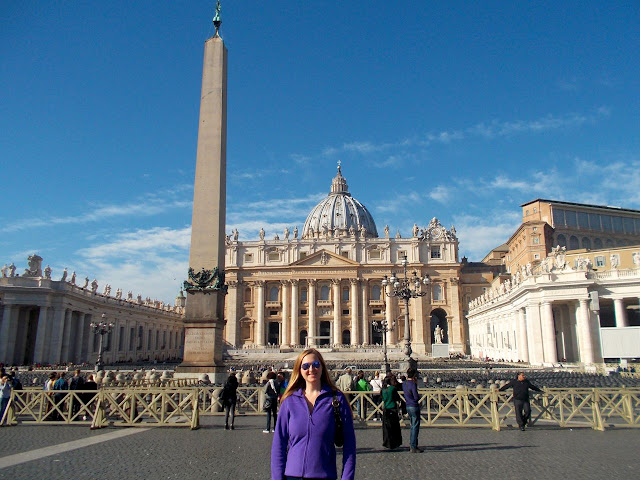
No comments:
Post a Comment